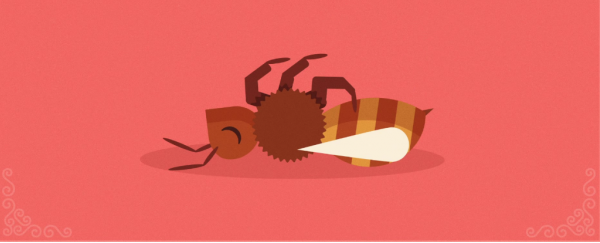
By now, everyone's heard of the great Colony Collapse Disorder that's threatening the survival of honey bee populations around the world. No country is immune, and there are no signs of it slowing down, but despite the best efforts of researchers, we still haven't been able to pin down an exact cause for this unprecedented phenomenon. What we do know, says the video above by German design studio Kurz Gesagt, is that it's a complex combination of factors, including poisons, parasites, and human activity, and until we figure out how they all fit together, we don't have a hope in hell of slowing down the decline.
So here's what we do know. We know that bees make possible one of every three meals eaten by humans around the world, and if they were wiped out, the blow to the global agriculture industry would see millions of people die from a lack of food. We know we'll lose an annual US$265 billion in revenue, and there'd be a massive decrease in everything from berries and avocados to beef, vegetables, cheese, and milk.
We know that there's been an annual loss of 30 to 90 percent of hives around the world over the past few years, and in the US alone, we've seen a decrease of 5 million hives in 1998 to 2.6 million in 2010 and now 2.5 million today. We also know that the Colony Collapse Disorder started affecting things in 2006, and has been a looming force ever since. "We're not entirely sure what's causing it," says the video above, "all we know is that it's pretty serious."
One of the biggest factors threatening the survival of honey bees are a number of particularly nasty parasites that infect them when they're young, and continue to feed off them for the rest of their lives. One of these is Acarapis woodi, which camps out in a bee's breathing tube, feeding on the fluids that pass through it and laying its eggs inside. This means that once a bee is infected, it will be a home to these parasites for the rest of its life.
Another parasite, a type of mite called Varroa destructor, is even more, well, destructive, because it's able to infect an entire hive. "The female mite enters the honey bee brood cell and lays eggs on the bee larva before it's about to pupate, and before the hive bees cover the cell with a wax capping." says the video above. "The eggs hatch, and the young mites and their mother feed on the developing bee in the safety of the capped cell."
Once the weakened bee has hatched from the brood cell, the mites and their mother will either continue feeding on its bodily fluids well into adulthood, or they will move on and infect more larvae. The mites will also pass on viruses that further weaken the bees and cause birth defects such as defective wings. This cycle will continue, with the numbers of mites growing exponentially, until the hive is ultimately destroyed.
While parasites are clearly a huge threat to the continued existence of our honey bees, they don't explain the severity of the Colony Collapse Disorder on their own, the video explains. We've only got ourselves to blame for that, as newly introduced pesticides and other detrimental human activities appear to be playing a significant role on top of the parasitic infections. I'll let the video explain what we're up against, and what we might be able to do to mitigate the damage. It's not just the bees that are at risk - if they go, a whole lot of us will go with them.
